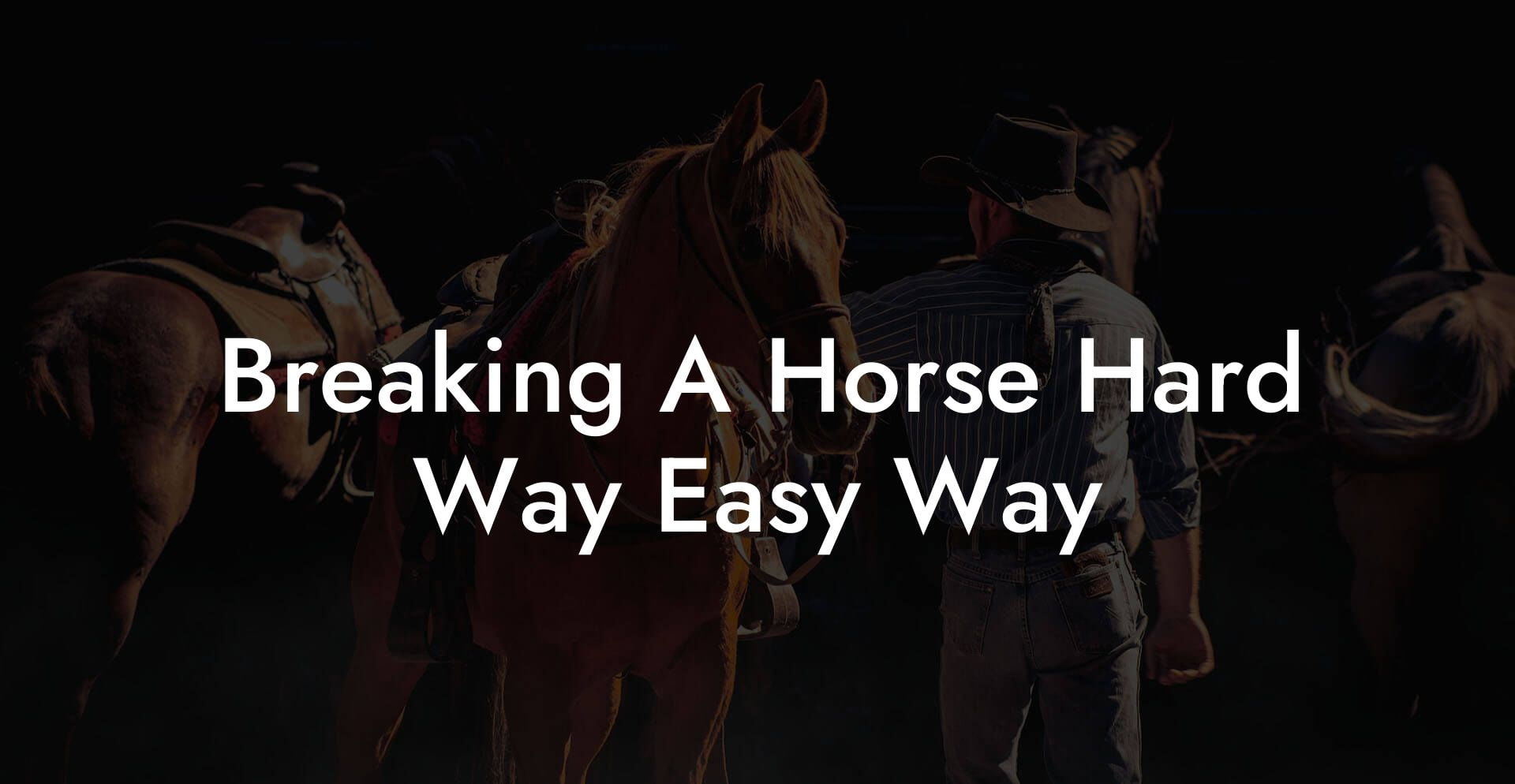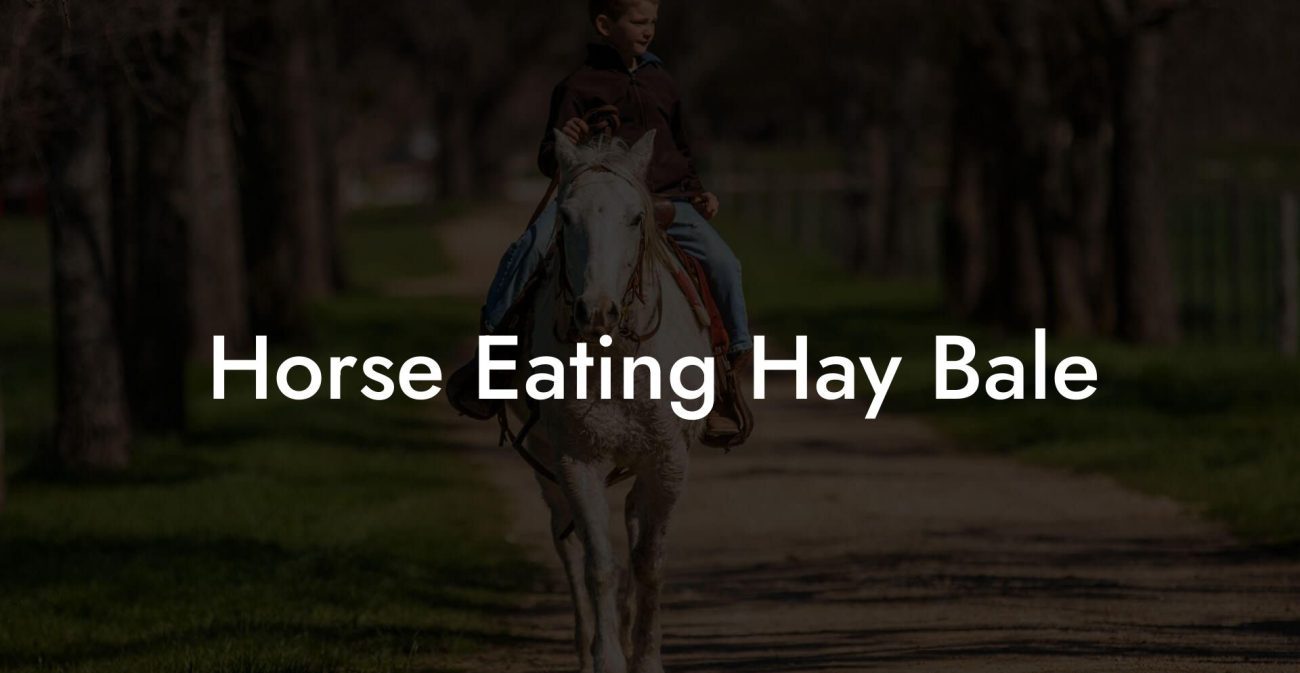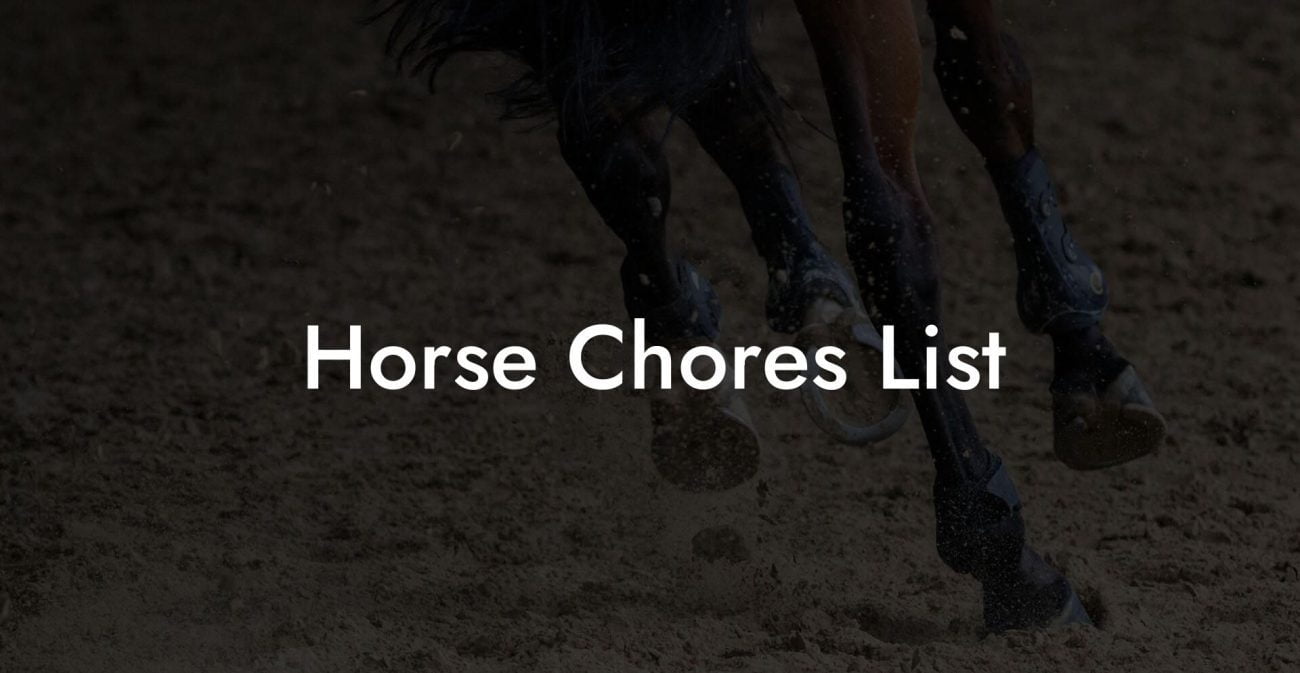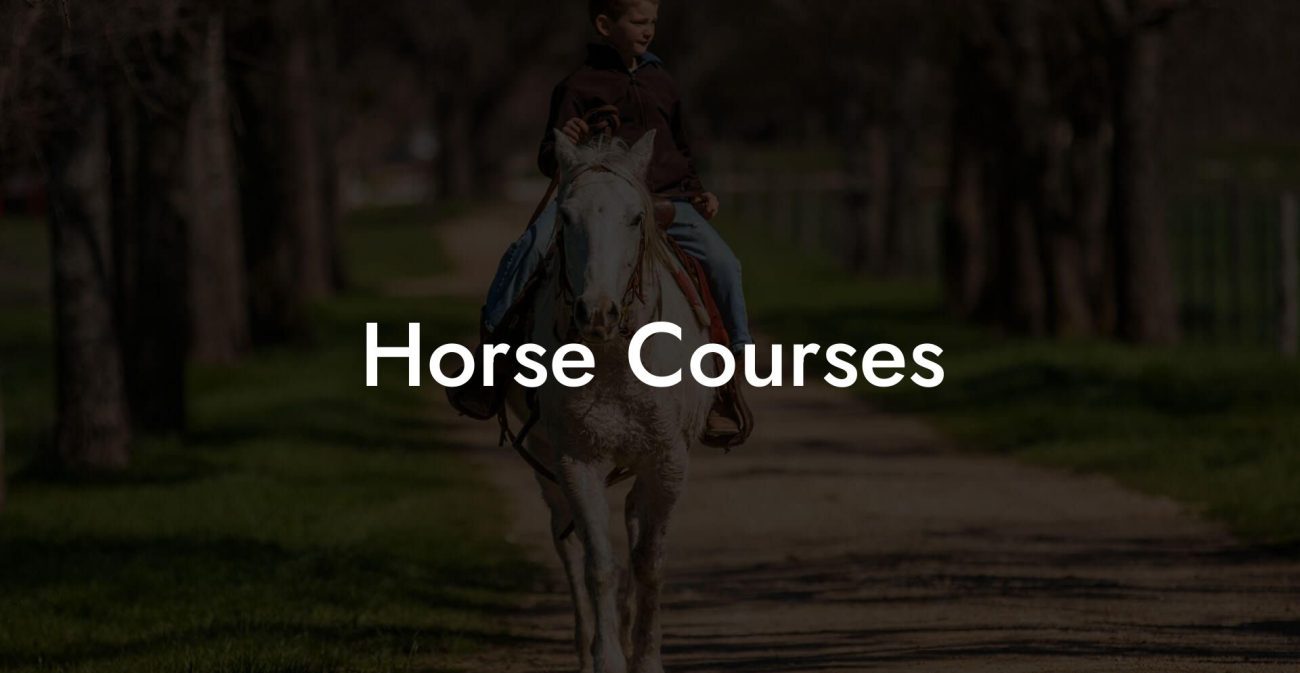Ever wondered how you can take the reins of horse care with a blend of old-school grit and a modern, breezy vibe? “Breaking A Horse Hard Way Easy Way” isn’t about harsh treatment, it’s about flipping the script on conventional methods and discovering a gentler, smarter approach that works just as hard (and even harder when it comes to results). If you’re a Gen-Z or millennial rider hungry for fresh, innovative insights on caring for your equine friend, saddle up as we explore an all-in-one guide that mashes up cutting-edge techniques, proven training basics, and a dash of humor to help you build an unbreakable bond with your horse.
Quick Links to Useful Sections
- What Does “Breaking A Horse Hard Way Easy Way” Really Mean?
- The Building Blocks of Modern Horse Care and Training
- Conventional Methods: The Backbone of Horse Training
- Classic “Breaking” Techniques
- Modern Adaptations of Conventional Methods
- Holistic Approaches: Embracing the Gentle Art of Horse Care
- Natural Horsemanship
- Mindfulness and Equine Energy
- Complementary and Alternative Therapies
- The Role of Nutrition: Fueling a Healthy Horse
- Essential Nutrients for Equine Health
- Grazing and Feeding Schedules
- Grooming, Hygiene, and the Art of Building Trust
- Daily Grooming Rituals
- Hygiene and Health Checks
- Mindset and Relationship Building: The Heart of Horse Training
- Developing a Mutual Understanding
- The Role of Positive Reinforcement
- Cultivating a Calm Environment
- Case Studies: From Spooky to Superstar
- Case Study 1: The Timid Trotter Turned Trailblazer
- Case Study 2: From Hoof-beaten to High-Spirited
- Case Study 3: Healing Through Holistic Health
- Creating Your Personalized Horse Training & Care Plan
- Step 1: Comprehensive Assessment
- Step 2: Define Clear Objectives
- Step 3: Mix and Match Techniques
- Step 4: Implement a Consistent Routine
- Step 5: Monitor, Reflect, and Adjust
- Resources and Community Support: Your Next Steps
- Equine equipment and Stable Setup: Your Environment Matters
- Must-Have Equipment
- Integrating Technology: Innovations in Horse Care
- Wearable Devices and Apps
- Digital Training Platforms
- Equine First Aid and Emergency Preparedness
- Your Journey to a Resilient, Rewarding Horse Bond
- Equine Care FAQs: Your Questions Answered
- Your Journey to an Empowered, Rewarding Equine Bond
What Does “Breaking A Horse Hard Way Easy Way” Really Mean?
At first glance, the phrase might evoke images of grizzled cowboys and stubborn steeds being whipped into shape. But in today’s world, breaking a horse isn’t about brute force, it’s about harnessing smart strategies and empathy to bring out the best in your four-legged partner. Think of it as flipping the old “tough love” paradigm on its head. While traditional methods might have leaned on sheer authority and intimidation, modern horse care emphasizes understanding, patience, and communication.
In essence, “Breaking A Horse Hard Way Easy Way” is the art of training your horse with consistency and care, combining proven techniques with innovative practices. The goal? Transform your horse’s behavior and well-being without sacrificing its trust or comfort. Whether you’re gearing up for competitive riding, trail adventures, or simply creating a harmonious environment in your stable, the approach is all about balance.
Throughout this guide, we’ll show you how to integrate conventional equine training methods with holistic lifestyle tweaks, nutritional guidance, and mental wellness strategies to build a secure and thriving connection with your horse.
The Building Blocks of Modern Horse Care and Training
To truly understand how to care for your horse in the 21st century, we need to break down the fundamentals of what makes a happy, healthy equine companion. Whether you’re a newbie in the saddle or a seasoned rider looking for fresh insights, these core elements are your blueprint for success:
- Training Techniques: Methods that balance respect with discipline, ensuring your horse learns commands through positive reinforcement and clear communication.
- nutrition and Hydration: A balanced diet tailored to horses’ unique digestive systems, paired with adequate hydration and essential supplements.
- grooming and Hygiene: Regular grooming routines to maintain skin health, promote blood circulation, and strengthen your bond through trust-building.
- Stable Management: Creating a safe, comfortable, and energizing environment that minimizes stress and encourages natural behaviors.
- Holistic Health: Incorporating mental well-being, stress reduction techniques, and complementary therapies to keep your horse both physically and emotionally balanced.
Combining these building blocks with a nuanced approach to training can turn potential struggles into triumphs. Let’s gallop into the specifics and uncover each element’s role in the grand tapestry of modern equine care.
Conventional Methods: The Backbone of Horse Training
For decades, conventional horse training has relied on time-tested routines and a strict regimen of physical and behavioral conditioning. While these methods might have once featured a heavy-handed touch, they remain valuable when applied with empathy and modern adjustments. Here’s a look at some traditional strategies and how they’re evolving:
Classic “Breaking” Techniques
Historically, breaking a horse involved establishing dominance through a series of assertive commands and sometimes physical prompts. The idea was to “tame” a wild spirit with a firm hand. Today, we know that true leadership comes from consistency and trust rather than fear or coercion.
Key Techniques:
- Desensitization: Gradually introducing your horse to new stimuli, from unexpected noises to unusual objects, helps reduce fear and build confidence.
- Groundwork: Implementing exercises on the ground, such as leading, yielding, and stopping, lays the foundation for advanced training.
- Consistent Cues and Commands: Using clear, consistent signals ensures that your horse understands what you’re asking, reducing miscommunication.
While these methods are effective, they work best when paired with a gentle approach that still respects the animal's nature. Over-reliance on harsh techniques can stunt a horse’s progress and injure the delicate trust needed for a lasting partnership.
Modern Adaptations of Conventional Methods
The modern twist on conventional training places emphasis on empathy, gradual progression, and ultimately, a relationship built on mutual respect. Techniques such as using treat rewards, clicker training, and even structured “time-outs” have become popular as they allow horses to learn commands in a stress-free environment.
Riders and trainers alike now recognize that fear-based approaches can backfire, leading to anxiety, behavioral issues, or even physical injury. By blending classic methods with a modern mindset, you can respect the horse’s natural behavior while still achieving the results you need.
Holistic Approaches: Embracing the Gentle Art of Horse Care
In the age of wellness and mindfulness, holistic approaches are redefining what it means to train and care for a horse. These strategies extend far beyond the arena and stable, integrating nutrition, mental health, and complementary therapies to create a well-rounded routine.
Natural Horsemanship
Natural horsemanship is all about understanding your horse’s instinctual behaviors and working with them instead of against them. This philosophy encourages you to trust your intuition and observe your horse’s body language, tailoring your approach accordingly. The result is a harmonious relationship where both trainer and horse communicate in a language of mutual respect.
Techniques like shadowing, where you mimic your horse’s movements, and body positioning, which involves using your physical stance to guide the horse, are fundamental. Rather than forcing submission, you gently guide your horse into the behaviors that will lead to a more efficient and enjoyable partnership.
Mindfulness and Equine Energy
Believe it or not, horses are incredibly in tune with energy. They sense your mood, your confidence, and yes, even your stress levels. Incorporating mindfulness into your training means taking a moment to center yourself before each session. Deep breaths, a calm demeanor, and a positive mindset create an atmosphere where your horse feels safe and ready to learn.
Some trainers even incorporate meditation practices into their routine, using soothing music and ambient sounds to ease both their own nerves and those of their horse. The more relaxed you are, the more your horse can relax, and that open channel of energy paves the way for smoother training sessions.
Complementary and Alternative Therapies
Beyond the basics of training, many riders are exploring complementary therapies to boost their horse’s overall well-being. These therapies can include:
- Acupuncture: Traditional Chinese medicine techniques adjusted for equine physiology have been shown to alleviate muscle pain, improve circulation, and boost overall vitality.
- Massage Therapy: Regular massages help relieve muscle tension, reduce stress, and enhance flexibility, which is key for performance and comfort.
- Herbal Supplements: From joint support to digestive health, certain herbs can be an excellent addition to your horse’s diet when used appropriately.
When these holistic approaches are combined with standard training methods, you create an environment that nurtures your horse on every level, physically, emotionally, and mentally.
The Role of Nutrition: Fueling a Healthy Horse
Just as you need a balanced breakfast to kickstart your day, your horse’s diet is the cornerstone of its health and performance. Feeding your horse the right mix of nutrients can enhance training outcomes, improve coat shine, and boost overall vitality.
Essential Nutrients for Equine Health
Horses require a diet that’s rich in fiber, moderate in protein, and balanced with essential vitamins and fatty acids. Here are some of the key components:
- Forage and Hay: The bulk of a horse’s diet should consist of high-quality hay or pasture. Fiber is critical for maintaining a healthy digestive system.
- Grains and Concentrates: These should be fed in moderation. When used appropriately, they provide the extra energy needed during hard training sessions.
- Supplements: Consider adding vitamins, minerals, and omega-3 fatty acids to support joint health, muscle recovery, and a glossy coat.
- Water: Horses require constant access to clean, fresh water. Hydration is key to nutrient absorption and overall health.
Consult with an equine nutritionist or use trusted feeding guidelines to ensure your horse’s dietary needs are met without overfeeding or creating digestive issues.
Grazing and Feeding Schedules
Unlike humans who have discrete meal times, horses are designed to graze throughout the day. A consistent feeding schedule mimics their natural behavior, which can reduce stress and promote better digestion. Split their daily intake into multiple small meals rather than one or two large ones, and pair feedings with water breaks and gentle exercise.
Whether you’re dealing with a high-performance athlete or a leisurely companion, a balanced diet makes a huge difference in recovery, training effectiveness, and long-term health.
Grooming, Hygiene, and the Art of Building Trust
Grooming isn’t just about keeping your horse clean, it’s an essential ritual that strengthens the bond between you and your equine partner. From brushing to bathing, every grooming session is a chance to communicate, relax, and build trust.
Daily Grooming Rituals
A consistent grooming routine does wonders. Here’s how to make the most of it:
- Brushing: Regular brushing removes dirt and loose hair while stimulating blood circulation.
- Hoof Picking: Daily hoof care prevents infections and keeps the hooves in peak condition.
- Bathing: Occasional baths, especially during hot weather, keep your horse cool and comfortable, but avoid over-bathing, as it can strip natural oils.
While you’re at it, give your horse a gentle massage around the neck and shoulders. Not only does it feel amazing, but it also signals affection and care.
Hygiene and Health Checks
Routine health checks, like dental care, vaccinations, and parasite control, are non-negotiable. A few extra minutes each week dedicated to monitoring your horse’s health can catch minor issues before they morph into major problems.
When combined, these grooming and health practices create a wellness routine that benefits both your horse’s physical state and its emotional well-being.
Mindset and Relationship Building: The Heart of Horse Training
Beyond techniques and checklists, successful horse training is rooted in the energy and connection between you and your horse. Just as a great friendship is built on trust, respect, and a sprinkle of fun, your approach to “breaking” a horse should be equally heartfelt.
Developing a Mutual Understanding
Horses are incredibly intuitive creatures. They pick up on subtle cues in body language and tone. Establishing a rapport means being consistent in your approach and patient in your expectations. The more you understand your horse’s moods and signals, the better you can adjust your training methods.
Start by simply spending time together, whether it’s a leisurely walk around the pasture or a quiet moment during grooming. These moments build a foundation of trust that is essential for effective training.
The Role of Positive Reinforcement
Positive reinforcement isn’t just a buzzword, it’s a game changer. Rewarding desirable behavior with treats, praise, or a gentle pat can work wonders. Over time, your horse will associate obedience and good behavior with positive outcomes, making the learning process natural and enjoyable.
This approach eliminates the need for harsh corrections and creates a training environment where your horse is excited to learn, not afraid of making mistakes.
Cultivating a Calm Environment
A calm environment is contagious. When you bring a relaxed, confident energy to every training session, your horse mirrors that state. Whether it’s setting up a quiet space in the stable or playing soft background music during sessions, these small adjustments go a long way in reducing stress and enhancing focus.
Remember, the goal is to build a relationship that feels less like a rigid training schedule and more like a dynamic dance between two partners in sync.
Case Studies: From Spooky to Superstar
Nothing illustrates the power of a balanced, integrative approach like real-life transformations. Let’s explore a few case studies that highlight horses – and their human partners – who turned challenges into success stories.
Case Study 1: The Timid Trotter Turned Trailblazer
Bella was once known for her skittish behavior. New stimuli, loud noises, or even the sight of a stranger could set her off. Her rider, Alex, decided to ditch the old, harsh training methods and embrace a gentler approach based on natural horsemanship. Beginning with daily desensitization exercises, mindful grooming sessions, and gradual exposure to new sounds, Bella’s transformation was nothing short of miraculous. Over several months, Bella gained confidence, became more relaxed, and eventually took on challenging trail rides like a true superstar.
Case Study 2: From Hoof-beaten to High-Spirited
Rocky, a once stubborn and temperamental horse, had a reputation for resisting basic commands. His owner, Jamie, blended traditional groundwork with modern positive reinforcement techniques. By incorporating clicker training, rewarding every small success, and integrating holistic practices such as calming music and regular acupuncture sessions, Rocky’s behavior radically improved. Not only did he start responding to commands more reliably, but his overall health and temperament also saw a significant uplift. Rocky’s journey is a testament to the fact that a balanced approach can turn even the most challenging horses into beloved companions.
Case Study 3: Healing Through Holistic Health
Luna had been struggling with minor health issues that made training sessions a source of frustration, for both her and her rider, Morgan. Incorporating regular massage therapy, a nutrient-enhanced diet, and a flexible training schedule adjusted to her energy levels, Morgan was able to improve Luna’s well-being gradually. Over time, Luna’s energy levels soared, her behavior improved, and the bond between her and Morgan deepened considerably. Her transformation clearly demonstrated that holistic health practices aren’t just for humans, they’re the key to unlocking a horse’s full potential.
These stories remind us that every horse is unique. With patience, empathy, and the right mix of traditional and modern approaches, you can overcome even the most daunting challenges on your journey to creating an unbreakable bond.
Creating Your Personalized Horse Training & Care Plan
Just as every human has a unique path to wellness, every horse requires a personalized care plan that reflects its individual needs and personality. Here’s a step-by-step guide to crafting a plan that works for both you and your horse:
Step 1: Comprehensive Assessment
Begin by evaluating your horse’s current state, both physically and emotionally. Consider factors like temperament, prior training, nutritional requirements, and overall health. Consult with equine professionals such as veterinarians, nutritionists, and experienced trainers to get a well-rounded assessment.
Step 2: Define Clear Objectives
Whether your goal is to prepare your horse for competitive riding, quiet trail excursions, or simply to enhance everyday care, establish clear, achievable objectives. Write them down and revisit them regularly to track progress.
Step 3: Mix and Match Techniques
Combine conventional training with holistic approaches. Design a schedule that rotates between groundwork, positive reinforcement sessions, and rejuvenating practices like massage or acupuncture. Variety not only keeps your horse engaged but also promotes balanced development.
Step 4: Implement a Consistent Routine
Consistency is your best friend in building trust and forming habits. Create a daily or weekly routine that covers training sessions, feeding times, grooming, and even quiet bonding moments. Use digital tools or a planner to track your routine and make adjustments as needed.
Step 5: Monitor, Reflect, and Adjust
Keeping a training journal can be invaluable. Record what works, note any changes in behavior or health, and be prepared to tweak your strategy. Every horse is a dynamic being, flexibility in your approach is essential.
Remember, your plan is a living document. As you and your horse evolve, so should your strategies. Embrace the journey of experimentation and discovery, knowing that every small win is a step toward a stronger bond.
Resources and Community Support: Your Next Steps
Finding a community of like-minded equestrians can be a game-changer. From local riding clubs and online forums to social media groups and professional workshops, there’s a treasure trove of resources to help you on your journey.
Here are some avenues to explore:
- Online Communities: Platforms like Reddit, Facebook, and Instagram are buzzing with horse enthusiasts sharing training tips, success stories, and even hilarious mishaps. Joining these groups can offer support, guidance, and a much-needed laugh.
- Local Riding Clubs: Find clubs or stables in your area where you can participate in group rides, workshops, and training sessions. These local hubs are a great way to meet experts and novices alike.
- Workshops and Seminars: Keep an eye out for events focusing on natural horsemanship, holistic care, and modern training techniques. These immersive experiences can provide hands-on learning and new perspectives.
- Professional Guidance: Don’t hesitate to consult specialized trainers, veterinarians, or equine nutritionists for personalized advice. Their expertise can help refine your techniques and ensure your horse’s well-being.
Leveraging these resources not only enhances your skills but also helps build a network of support. Remember, every rider’s journey is unique, and connecting with others can offer both inspiration and practical tips to keep you on track.
Whether you join an online forum or attend a local workshop, engaging with the community can provide that extra boost of confidence and creativity as you continue refining your personalized horse care plan.
Equine equipment and Stable Setup: Your Environment Matters
A well-equipped stable and the right gear can make all the difference in both training and everyday care. Modern equine equipment is designed to enhance safety, comfort, and efficiency, ensuring that your horse feels right at home.
Must-Have Equipment
Whether you’re setting up a new stable or upgrading your current setup, consider these essentials:
- Quality Tack: Invest in properly fitted saddles, bridles, and halters that ensure comfort for your horse and control for you.
- Stable Supplies: Bedding, feeders, water buckets, and grooming tools should be chosen for both durability and ease of cleaning.
- Training Aids: From lunge lines and round pens to clickers and treat dispensers, these tools help standardize training sessions.
- Safety Gear: For both rider and horse, safety equipment such as helmets, reflective vests, and first-aid kits are crucial.
A well-maintained stable environment not only supports physical training but also minimizes stress, creating a safe haven where your horse can thrive.
Integrating Technology: Innovations in Horse Care
Technology isn’t just for our smartphones and laptops, it’s making waves in the world of equine care as well. Modern innovations can help monitor your horse’s health, guide training sessions, and even track their performance.
Wearable Devices and Apps
Imagine having a wearable tracker tailored for horses, monitoring heart rate, activity levels, and even sleep patterns. These devices can provide real-time insights into your horse’s well-being and alert you to any abnormalities before they become major issues.
Digital Training Platforms
A range of apps and online platforms now offer everything from training tutorials to virtual coaching sessions. They allow you to log progress, schedule routines, and share your successes with an online community, ensuring you’re never left in the dark.
By leveraging technology, you’ll be better equipped to tailor your training program, monitor progress, and eventually see tangible improvements day by day.
Equine First Aid and Emergency Preparedness
Caring for a horse isn’t all about day-to-day training and grooming, sometimes, you need to be prepared for unexpected challenges. Keeping a well-stocked first aid kit and knowing basic emergency procedures can be the difference between a minor scare and a major crisis.
Educate yourself on common equine emergencies, familiarize yourself with essential treatments, and make sure you know when it’s time to call in a veterinarian. A little preparation goes a long way in ensuring your horse’s safety and your peace of mind.
Your Journey to a Resilient, Rewarding Horse Bond
Embracing the “Breaking A Horse Hard Way Easy Way” philosophy isn’t about taking shortcuts or compromising on care. It’s about being smart, kind, and innovative in how you train and nurture your horse. Every tactic, from blending conventional methods with modern, holistic ideas to refining your stable management and nutrition, builds collectively toward a robust, enduring bond.
Every step you take, every extra minute spent in mindful grooming or training, echoes in the health and happiness of your horse. It’s a journey of continuous learning, adaptation, and love, a journey that proves that hard work can be fun, effective, and gentle all at once.
So, as you step back into the arena of horse care, remember that each moment of patience and each burst of creativity enriches the partnership between you and your equine companion. Embrace the modern way, celebrate the small wins, and look forward to a future where every ride, every training session, and every quiet moment in the stable makes your bond stronger than ever.
Equine Care FAQs: Your Questions Answered
Get ready to gallop through some of the most common questions about modern horse training and care. Here, we’ve rounded up answers to the burning queries you, and many others, have had on this dynamic journey.
1. What does “Breaking A Horse Hard Way Easy Way” actually mean?
It’s about blending traditional training methods with modern, gentle approaches to create a respectful, effective way to train your horse. It’s not about harsh treatment, instead, it emphasizes balance, empathy, and consistency.
2. How do I know if my horse responds better to conventional or holistic methods?
Observe your horse’s reaction to different techniques. Some horses thrive on consistency and clear cues, while others respond better when training is coupled with relaxation techniques, mindfulness, or holistic care. Experiment with both approaches in a controlled manner.
3. Can wearable technology really track my horse’s health?
Yes, modern devices can monitor heart rate, activity, and even sleep patterns. They offer valuable insights that help you detect issues early and tailor your care plan accordingly.
4. What role does nutrition play in my horse’s performance?
Nutrition is fundamental. A balanced diet that mimics natural grazing and includes high-quality forage, essential supplements, and proper hydration directly influences your horse’s energy, coat health, and overall performance.
5. Are positive reinforcement methods effective in horse training?
Absolutely. Rewarding good behavior with treats, praise, and gentle physical gestures fosters trust and makes training enjoyable for your horse.
6. How often should I groom my horse to build trust?
Daily grooming sessions are ideal. They help maintain hygiene, encourage circulation, and offer daily opportunities to strengthen your bond.
7. What complementary therapies can help improve my horse’s well-being?
Many riders incorporate acupuncture, massage therapy, and herbal supplements into their routine for muscle relief, improved circulation, and overall vitality.
8. How important is a stable’s environment in horse care?
An optimal environment reduces stress and facilitates training. The right equipment, clean stable conditions, and safe pastures are all crucial for your horse’s happiness and health.
9. Can I train my horse at home without professional intervention?
Yes, with the proper research, resources, and patience, many riders successfully train their horses at home. However, consulting professionals for initial guidance is always a smart choice.
10. Where can I find support and resources as a new rider?
Online communities, local riding clubs, workshops, and forums are all excellent places to start. Engaging with experienced riders can boost your confidence and sharpen your skills.
Your Journey to an Empowered, Rewarding Equine Bond
The road to mastering horse care and training is paved with curiosity, persistence, and a willingness to embrace both tradition and innovation. By integrating conventional strategies with modern, holistic practices, you’re not just training a horse, you’re forging a partnership built on respect, trust, and mutual growth.
Every grooming session, training drill, and mindful moment is an opportunity to deepen the connection between you and your horse. As you navigate this journey, remember that the essence of “Breaking A Horse Hard Way Easy Way” lies in rethinking old paradigms and creating a pathway that’s as nurturing as it is effective.
So take that step forward, experiment with new methods, and celebrate each small victory along the way. Your commitment to compassionate, innovative horse care will not only transform your horse’s life but will also open the door to countless rewarding adventures together.
Embrace the challenge, enjoy the process, and let every ride remind you that caring for a horse, when done the smart, gentle way, is one of life’s most fulfilling journeys.













